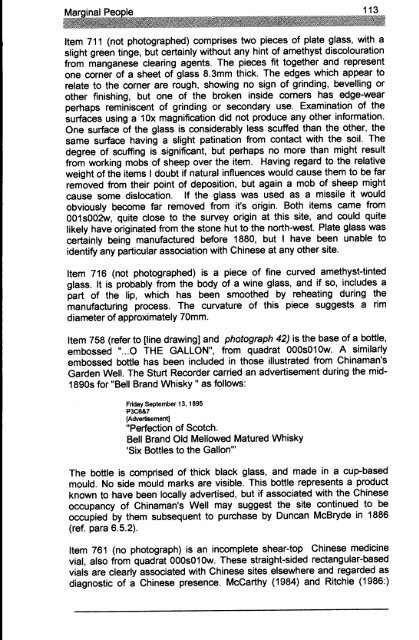Adec Preview Generated PDF File - The Sydney eScholarship ...
Adec Preview Generated PDF File - The Sydney eScholarship ...
Adec Preview Generated PDF File - The Sydney eScholarship ...
You also want an ePaper? Increase the reach of your titles
YUMPU automatically turns print PDFs into web optimized ePapers that Google loves.
Item 711 (not photographed) comprises two pieces of plate glass, with a<br />
slight green tinge, but certainly without any hint of amethyst discolouration<br />
from manganese clearing agents. <strong>The</strong> pieces fit together and represent<br />
one corner of a sheet of glass 8.3mm thick. <strong>The</strong> edges which appear to<br />
relate to the corner are rough, showing no sign of grinding, bevelling or<br />
other finishing, but one of the broken inside corners has edge-wear<br />
perhaps reminiscent of grinding or secondary use. Examination of the<br />
surfaces using a 10x magnification did not produce any other information.<br />
One surface of the glass is considerably less scuffed than the other, the<br />
same surface having a slight patination from contact with the soil. <strong>The</strong><br />
degree of scuffing is significant, but perhaps no more than might result<br />
from working mobs of sheep over the item. Having regard to the relative<br />
weight of the items I doubt if natural influences would cause them to be far<br />
removed from their point of deposition, but again a mob of sheep might<br />
cause some dislocation. If the glass was used as a missile it would<br />
obviously become far removed from it's origin. Both items came from<br />
001s002w, quite close to the survey origin at this site, and could quite<br />
likely have originated from the stone hut to the north-west. Plate glass was<br />
certainly being manufactured before 1880, but I have been unable to<br />
identify any particular association with Chinese at any other site.<br />
Item 716 (not photographed) is a piece of fine curved amethyst-tinted<br />
glass. It is probably from the body of a wine glass, and if so, includes a<br />
part of the lip, which has been smoothed by reheating during the<br />
manufacturing process. <strong>The</strong> curvature of this piece suggests a rim<br />
diameter of approximately 70mm.<br />
Item 758 (refer to [line drawing] and photograph 42) is the base of a bottle,<br />
embossed "...0 THE GALLON", from quadrat 000s010w. A similarly<br />
embossed bottle has been included in those illustrated from Chinaman's<br />
Garden Well. <strong>The</strong> Sturt Recorder carried an advertisement during the mid<br />
1890s for "Bell Brand Whisky" as follows:<br />
Friday September 13, 1895<br />
P3C6&7<br />
[Advertisement]<br />
"Perfection of Scotch.<br />
Bell Brand Old Mellowed Matured Whisky<br />
'Six Bottles to the Gallon'"<br />
<strong>The</strong> bottle is comprised of thick black glass, and made in a cup-based<br />
mOUld. No side mould marks are visible. This bottle represents a product<br />
known to have been locally advertised, but if associated with the Chinese<br />
occupancy of Chinaman's Well may suggest the site continued to be<br />
occupied by them subsequent to purchase by Duncan McBryde in 1886<br />
(ret. para 6.5.2).<br />
Item 761 (no photograph) is an incomplete shear-top Chinese medicine<br />
Vial, also from quadrat 000s010w. <strong>The</strong>se straight-sided rectangular-based<br />
vials are clearly associated with Chinese sites elsewhere and regarded as<br />
diagnostic of a Chinese presence. McCarthy (1984) and Ritchie (1986:)




